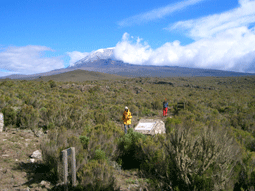 |

The Woes of Kilimanjaro
by Kate Cheney Davidson

The view of Kibo, Mt. Kilimanjaro's last remaining glaciated peak, from 11,300 feet. Scientists expect the glaciers on Kibo will disappear in the next 10-to-15 years following a worldwide trend of glacial retreat due to global warming. Photo: Kate Cheney Davidson
On a sun baked farm a half-mile below Kilimanjaro National Park, the evidence of a changing climate is obvious.
William Kiwali, chairman of the small village of Kifura, leads us into a field of parched cornstalks that lean like drunkards at a bar. His farm, like many others on the slopes of Kilimanjaro, is not doing well.
"I'm a farmer. I grow coffee, corn, and bananas," says Kiwali through a translator. "My farm is dry now, and so are the other farms, because there is not enough water."
Normally this region of East Africa receives two periods of precipitation, but the short rains, which were due in September, haven't come for the past three years. Mr. Kiwali's farm is one of hundreds that blanket this area, located in Mt. Kilimanjaro's rain shadow, and despite occasional droughts, there's usually plenty of water here. But Mr. Kiwali says this is not the land he remembers as a child.
"In the past," says Kiwali, "there was a lot of ice on the mountain, and the rivers were so full we could not cross them. Now there's not enough water and the ice is diminished."
For generations, people here have relied on a clever system of furrow irrigation. It can send water to farms miles away from any source. But now local villagers say the rivers and streams that feed the irrigation ditches are starting to go dry.

Parched corn leans listlessly on a farm near the village of Kifuru, located at about 5,000 feet on Mt. Kilimanjaro's south side. Local farmers say corn harvests have suffered for the past three years due to lack of rain. Photo: Jon Lewis
"There's not enough water for people, so they start quarreling," says Kiwali. "Sometimes they cut each other with machetes. It's not normal. In the past there was no such thing."
"We're not just in a period of a few bad years," says Kelly West with the World Conservation Organization based in Eastern Africa. "Climate change is happening and people need to change the way they use water. People are still in the mentality that we're just having a bad year, but you're not going to have the rains that you remember from your childhood again."
There's one region where the future is already here. As you might expect, it's downstream. The people of Mwangaria, a village on the dry, dusty savanna below Mt. Kilimanjaro, are losing their traditional sources of water. In this part of Africa, as in some other places that fortune has skipped over, climate change is likely to aggravate what humans have already done to the landscape.
"Sometimes we had drought, but not like this," says Israeli Saguro, a 52-year-old man from Mwangaria. "I think it has been three years now and we have harvested nothing. When you grow corn, they dry up before they can blossom. It used to be different than it is now. When there wasn't drought, I lived a happy life. I wasn't suffering like I am now. I had plenty of food and water, and the weather was good. Now it's extremely hot and there is no day when the weather is good."
Mr. Saguro gets up from the couch in his modest house made of narrow logs chinked with mud. Gently, he lifts a small wooden instrument from a peg on the wall. It's called an irimba, and his father showed him how to make it.
Mr. Saguro tells us he knows exactly what song he wants to play. "I wanted to play this song because I see what is happening now in this generation."
The song says people are dying and asks, "Who is willing to climb aboard the Lord's ship to help?"
Back to Reports from a Warming Planet